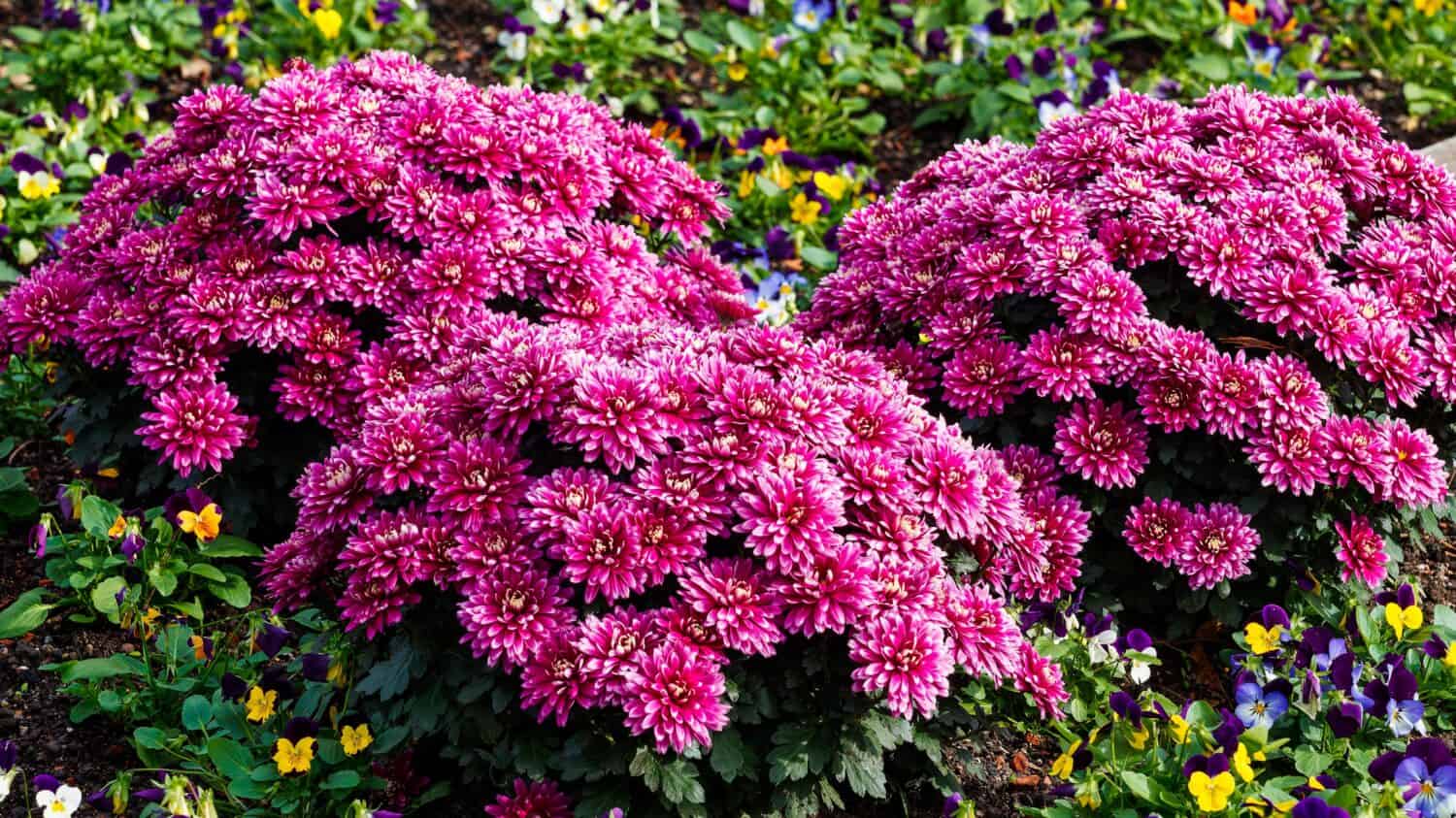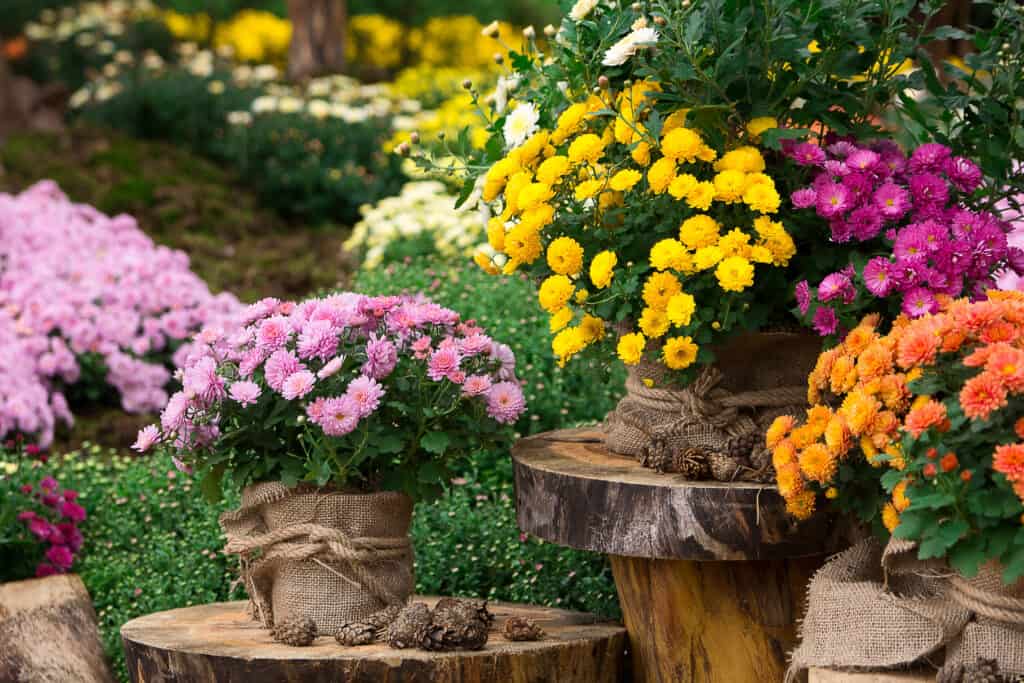Using mums is a great way to add beautiful color to your garden or landscape in the fall. Also known as chrysanthemums, these flowers have tight blooms that form a round shape overall. They look great in a garden as well as in pots as part of seasonal decor. Because mums are so easy to care for, they make a great addition to your home or yard.
But when exactly can we expect these brilliant flowers to bloom? The answer depends on the type of mum as well as your location. Fall is definitely the season for mums. Early bloomers show their flowers in late July. Mid-bloomers wait until September. Late bloomers go into full bloom by October. Most varieties keep their flowers for a few weeks, sometimes up to a month or more. While some people use mums to add color to their decor or porch for just a season, there are ways to extend their blooms and even allow them to come back year after year.
Peak Blooming Seasons

Chrysanthemums come in fall colors, making them a perfect addition to your seasonal decor or a fall garden.
©New Africa/Shutterstock.com
Mums are synonymous with fall because this is the season when they come into full and brilliant bloom. With plenty of fall colors, such as orange, yellow, or rust, as well are bolder hues like maroon or purple, these perennials are a great addition to your fall garden or porch decor. There are a wide variety of colors so you can really customize this flower to suit your decor. They have dark green foliage, although the flowers really become the stars of the show once they bloom.
The earliest bloomers start in late July and others continue their show all the way through October. The peak time for most mums is around mid-September, although this can vary depending on the conditions and the specific plants.
Factors Influencing Bloom Time

This map shows the hardiness zones in Northern and Central California, which range from 5a to 10b.
One of the biggest factors impacting both bloom time and duration is location. Fortunately, the United States Department of Agriculture helps gardeners and landscapers easily know which plants do well in different environments using a classification system called hardiness zones. There are 13 total zones with additional subzones. They range from zone 1 in the coldest parts of Alaska to zone 13 in Puerto Rico. To determine the zones, the USDA looked at the lowest temperatures in that area over a period of time. Every zone covers 10 degrees and each subzone covers 5 degrees.
Using these zones, it is easier to know where mums do well and when to expect them to bloom. Before you decide on which mum to buy, you’ll need to know which type it is. Garden mums or hardy mums are generally larger and tougher, hence the name hardy. They can survive in colder temps and often survive the winter when cared for properly. Florist mums, on the other hand, are smaller and typically stay in small pots during the season. Once the season is over, they can be tossed.
Garden Mums

Hardy mums tend to be larger and do well in gardens, although they can also be grown in pots.
©MacBen/Shutterstock.com
These mums can grow in zones 4 through 9 without any issues. They don’t require a lot of care or attention, although you should make sure to put them in a sunny place for the best blooms. If they get 8 hours of full sun each day, these plants will be very happy. They also require daily watering to keep the soil from getting too dry.
Florist Mums

Smaller florist mums do well in pots indoors.
©Helen Sushitskaya/Shutterstock.com
With more delicate plants, florist mums don’t do well in cooler temperatures. They generally need to stay within zones 7 through 9 when kept outdoors. Like garden mums, they need plenty of sun and water. If you’re in a cooler zone or are expecting a cold spell, you can bring these flowers indoors to keep them warm. Because they are often kept in pots, it can be easy to move florist mums around as needed.
Extending Bloom Time

Look for chrysanthemums that are still tightly closed to be able to enjoy their full flowers longer.
©Helga Fluey/Shutterstock.com
One of the easiest ways to extend the bloom time of your mums is to buy them before they hit their peak. While mums in full bloom look great in the store or garden center, they’ll be past their prime within days of bringing them home. Instead, look for mums whose flowers are still in tightly closed buds. They’ll begin to open within a few days or weeks. The bloom will extend for the following month and you’ll be able to enjoy plenty of flowers during the season.
Pruning your mums can also help them bloom more. This is because when you prune plants, it removes dead or weak sections, leaving nutrients and energy for the plant to put into the healthy sections that will flower. To prune mums, carefully remove dead leaves and cut back small branches that do not flower. While mums don’t require pruning and aren’t picky about it, pinching off dead leaves and flowers can allow more space for healthy leaves and flowers to flourish. It also generally helps your plant look better. Overcrowding can cause mums to produce fewer or smaller flowers because they just don’t have the room that they need.
But don’t worry if you can’t keep up with pruning and pinching. These plants don’t require much maintenance and some gardeners even think that the spent foliage acts as insulation during the colder months and should be left on the plant.
Fertilization can help mums get the nutrients that they need to produce strong, beautiful flowers and foliage. But this works best when applied during the spring and summer when the plant is actually growing and taking in all of these nutrients. Applying fertilizer after they bloom won’t have much of an impact on bloom time or plant health.
Planting Mums as Perennials

You can keep your chrysanthemums in pots or plant them in the spring to let them take root.
©Savina Nataliia/Shutterstock.com
Mums are perennials, which means they come back each year. However, because most mums come in small pots and do not have well-established root structures, it’s unlikely that they’ll survive beyond the fall when they bloom. If you do want to plant a mum as a perennial, the best time to do that is in the spring. The plants spend spring and summer putting down roots before they bloom in the fall. However, most people aren’t thinking of mums in the spring and they can be harder to find in stores. If you pick up mums in the fall and plant them while the buds are still very tight, they might be able to get a good enough root structure going for them to survive the winter and return the following year. However, it’s a much bigger risk and may require some extra attention in the form of water and a sun lamp.
Even if you get the plants into the ground in early spring, you should make sure that the roots are protected from cold temperatures. Hardy mums do well in zone 4, where temperatures can get as low as -20 degrees Fahrenheit. In these cases, however, adding a layer of mulch over the base of the plant will insulate and protect its roots through the winter. Some growers recommend bringing your mums indoors in zone 4 for the best results and definitely doing so in any colder environments.
Thank you for reading! Have some feedback for us? Contact the AZ Animals editorial team.








